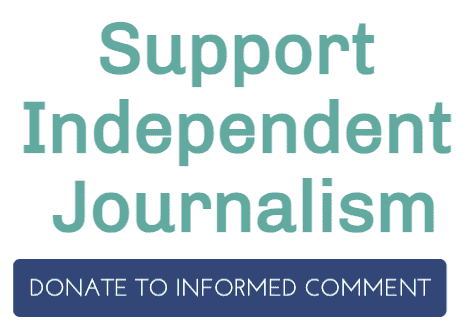Braga, Portugal and San Marcos, Ca. (Special to Informed Comment; Feature) – US President Trump arrived in Israel on Monday as the first hostages were released by Hamas, ostensibly to take credit for brokering the ceasefire, still hurt from the fact that he was not nominated for the Nobel Peace Prize. However, the Sumud Flotilla also deserves credit for creating momentum for the ceasefire and for being nominated for the Prize. Sumud began as a small fleet of hope — dozens of boats carrying activists, doctors, and humanitarian cargo, setting sail from ports around the world to challenge Israel’s blockade on Gaza.
Now, after months of confrontation, detention, and diplomatic fallout, the flotilla’s central message has unexpectedly materialized in political reality: Israel and Hamas have agreed to a provisional ceasefire that will allow humanitarian aid to flow freely into Gaza and has facilitated the release of hostages and prisoners.
To consolidate the truce and chart a political path forward, leaders from across the Middle East have gathered in Sharm el-Sheikh, Egypt. The summit, attended by heads of state from Egypt, Saudi Arabia, Jordan, the United Arab Emirates, and Qatar, alongside representatives from Europe and the United States, marks the most ambitious diplomatic initiative since the start of the Gaza war.

Or by check:
Juan Cole
P. O. Box 4218,
Ann Arbor, MI 48104-2548
USA
(Remember, make the checks out to “Juan Cole” or they can’t be cashed)
Yet beyond the closed doors of the conference center, another force has emerged. From Tehran to Rome, from Paris to Buenos Aires, millions have taken to the streets in support of Gaza and the Sumud mission’s ideals. The sheer scale of these demonstrations has sent a global message that diplomacy cannot be detached from public conscience.
It is a moment charged with relief, uncertainty, and moral resonance. What began as a maritime act of defiance has coincided with a political breakthrough. The very goals for which hundreds of activists were arrested at sea, unimpeded aid, civilian protection, and recognition of humanitarian law, have now been written into the language of a ceasefire.
Still, optimism is tempered by realism. Both sides remain deeply mistrustful. Israel insists that Hamas must ultimately disarm; Hamas maintains that any future political arrangement must include complete withdrawal from Gaza. The ceasefire, while welcome, is a tenuous pause in a larger, unresolved conflict.
A Fragile Breakthrough
At the heart of the talks lies a question that has haunted the region for decades: can a ceasefire lead to a durable peace, or will it simply postpone the next round of violence? For now, delegates are focusing on immediate humanitarian priorities — expanding the aid mechanism, establishing secure corridors for civilians, and defining the conditions under which prisoners will be exchanged.
After weeks of negotiations, Hamas agreed to release Israeli hostages. At the same time, Israel will permit the entry of food, medical supplies, and essential goods into Gaza through newly opened corridors. The agreement also includes a reciprocal release of Palestinian prisoners and a commitment to halt primary military operations. For the first time in months, aid convoys are rolling through the crossings without obstruction, bringing flour, fuel, and medical kits to a population teetering on the edge of famine.
This was, in many ways, the principal demand of the Sumud Flotilla — that Gaza’s civilian population not be collectively punished, that food and medicine not be used as weapons of war. The flotilla’s ships were seized, its passengers imprisoned or deported, yet their central appeal has now become a line in an international accord.
A European Awakening
During the Russian invasion of Ukraine in 2022, European citizens displayed the blue and yellow of Ukraine in their windows and public squares, motivated by a sense that war had come to their doorstep. That movement was driven by proximity — the conviction that Europe itself was under threat.
Never miss an issue of Informed Comment: Click here to subscribe to our email newsletter! Social media will pretend let you subscribe but then use algorithms to suppress the postings and show you their ads instead. And please, if you see an essay you like, paste it into an email and share with friends.
Three years later, the marches for Gaza reveal a different kind of awakening. This new civic wave represents something more profound than solidarity; it is a moral evolution. In Rome, half a million Italians filled Piazza Venezia, waving Palestinian flags and chanting for an end to the siege. In Madrid, crowds marched under banners reading “Free Palestine.” In Berlin, Paris, and Brussels, students and workers staged vigils and sit-ins, calling on their governments to halt arms sales and recognize Palestinian rights.
Europeans now rally not because the war is near, but because its injustice is universal. The sentiment, expressed in countless homemade signs, is straightforward: no child should be killed, no family starved, no city besieged — no matter who the aggressor is or where the borders lie. The moral distinction between “our” wars and “theirs” has begun to dissolve. To many Europeans, the lesson of Ukraine has matured into a broader ethic: that solidarity must extend beyond geography.
Inside Gaza, the reality remains fragile. Israel continues to coordinate with certain local militias, including factions led by Yasser Abu Shabab, to locate and dismantle Hamas’s remaining underground bases in the south. Officials insist this cooperation is tactical, but critics caution that empowering paramilitary groups risks deepening chaos and abuse.
What is clear, however, is that humanitarian aid must not become a bargaining chip in this equation. Food and medicine cannot be weaponized. Every shipment held up at a checkpoint — every hospital left without power — undermines the very logic of the ceasefire. If Israel wants to maintain legitimacy in this new phase, it must allow the full and free distribution of humanitarian supplies, without political or military conditions.
The Sharm el-Sheikh summit thus unfolds under twin pressures: the fragile trust between adversaries, and the moral demand rising from the streets. Leaders know that this ceasefire is not merely a regional issue; it is a test of global order. The chants echoing through European cities — “No more starving children” — are as much an indictment of global hypocrisy as of the war itself.

“Madleen,” Digital, Midjourney, 2025
For the first time in years, the moral energy of civil society appears to be outpacing the caution of governments. Citizens who once hung Ukrainian flags from their balconies now carry Palestinian ones through city centers, declaring that empathy must not depend on proximity. Their protests have become the moral soundtrack to the diplomacy unfolding on the shores of the Red Sea.
When the Sumud Flotilla set sail months ago, few could have imagined that its mission — to force the world to look at Gaza — would culminate in this moment. Though its ships were seized and its crews detained, its moral momentum has proved unsinkable. The flotilla’s message has moved from the decks of intercepted boats to the streets of global capitals, and finally to the negotiating tables of world leaders.
Whether this ceasefire holds or collapses under the weight of politics remains uncertain. But for now, a measure of hope has been restored. Children in Gaza are receiving food again. Aid convoys are crossing checkpoints. Diplomats are speaking rather than firing. And across continents, citizens, from Tehran to Rome, from Sana’a to Stockholm, are discovering that solidarity, once set in motion, can be harder to blockade than any ship at sea.


 © 2025 All Rights Reserved
© 2025 All Rights Reserved